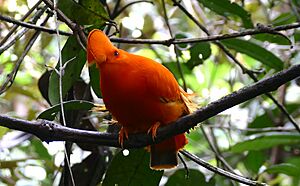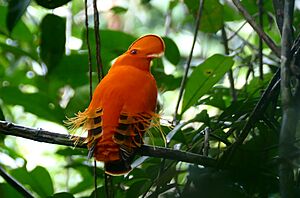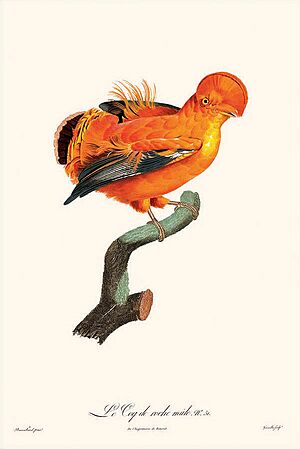Guianan cock-of-the-rock facts for kids
Quick facts for kids Guianan cock-of-the-rock |
|
|---|---|
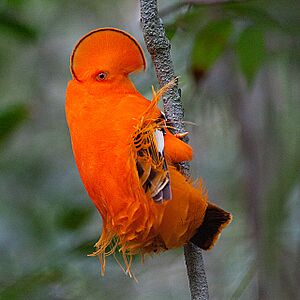 |
|
| Male | |
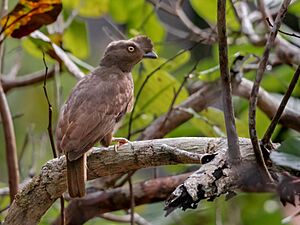 |
|
| Female | |
| Conservation status | |
| Scientific classification | |
| Genus: |
Rupicola (bird)
|
| Species: |
rupicola
|
 |
|
| Synonyms | |
|
Pipra rupicola Linnaeus, 1766 |
|
The Guianan cock-of-the-rock (Rupicola rupicola) is a special bird from South America. It is a type of cotinga, which is a kind of passerine bird. These birds are about 30 cm (12 inches) long. They weigh around 200 to 220 grams (7 to 7.8 ounces).
You can find them in tropical rainforests. They especially like areas near rocky cliffs. The male birds are very bright orange. They have a cool half-moon shaped crest on their heads. Females are brownish-grey and blend in more. Both male and female birds have strong bodies and wide beaks.
The Guianan cock-of-the-rock is one of two species in its group. The other is the Andean cock-of-the-rock. Guianan cocks-of-the-rock live in the forests of northeastern South America. They mostly eat fruit. But sometimes they also snack on small snakes or lizards.
These birds breed early in the year. Females usually lay their eggs around March. Males do special dances to attract females. Males and females live apart most of the time. They only come together to mate.
Contents
About the Guianan Cock-of-the-Rock
The Guianan cock-of-the-rock is a sturdy bird. It has a very noticeable crest on its head. Males and females look different, which is called sexual dimorphism. The male's crest is bigger and bright orange. Males also have a black tail with orange tips. Their wings are black, orange, and white. They have a bright orange beak and orange eyes.
The female bird is less colorful. She is mostly dark brownish-grey. Her beak is black with a yellow tip. Her crest is also smaller. Young male birds look like adult females at first. But they get orange spots as they grow. By three years old, males have their full bright orange feathers. Young females look much like adult females.
Guianan cocks-of-the-rock are about 30 cm (12 inches) long. They weigh between 200 and 220 grams (7 to 7.8 ounces). The two types of cock-of-the-rock live in different areas. This means they do not meet each other. The male Andean cock-of-the-rock is redder. Its wings are mostly black. The female Andean cock-of-the-rock is reddish-brown.
What's in a Name?
The name "Rupicola" comes from Latin words. "Rupes" means "rock" or "cliff". "Cola" means "inhabiting". So, the name means "rock-dweller". This describes how they build their nests on rock walls.
Where They Live and What They Eat
The Guianan cock-of-the-rock lives in the Guianan Shield. This area includes French Guiana, Suriname, and Guyana. You can also find them in southern Venezuela and northern Brazil. They like humid forests near rocky places. They usually live at heights of 300 to 2000 meters (980 to 6,560 feet).
Males have special areas they claim. They clear away leaves and twigs from the ground. This clean spot is called a "court". The quality of a male's court can affect if a female chooses him. Better courts are often in the middle of a group of males.
What Do They Eat?
Adult Guianan cocks-of-the-rock mainly eat fruit. This means they are frugivorous. They eat fruit from many different trees and vines. About 75% of the fruit they eat is black or red.
One researcher saw them eating papayas. He thought the birds ate papayas elsewhere. Then they dropped the seeds near their nests on rocks. This helped new papaya plants grow. Sometimes, they also eat small snakes, lizards, insects, and frogs. By spreading seeds, these birds help the forest grow.
Life Cycle and Reproduction
Guianan cocks-of-the-rock breed early in the year. Females lay their eggs around March. They build nests in rocky areas. During mating season, many males gather in special places called leks. A lek is like a dance floor where males show off. Each male has his own court on the forest floor. These courts are about 1 meter (3 feet) wide. Other males are usually about 3 meters (10 feet) away.
Females and males live separately. Females fly to the lek to watch the males. They choose a male by tapping him from behind. Then, mating happens quickly. Males stand tall and show off when females come near.
How Males Attract Mates
A male's success in mating depends on many things. His bright feathers are important. The way the lek is set up also matters. Females seem to choose males that are more successful. These males often have courts in the center of the lek. Females like larger leks where males are closer together. This shows that females actively choose their mates.
Nesting Habits
Unlike some other birds, the Guianan cock-of-the-rock builds its nest on rocky cliffs or in caves. They do not build nests in trees. The female lays one or two eggs. The nest is made of mud and plants. It is stuck to a vertical rock with the bird's saliva.
The female does all the work. She builds the nest and keeps it clean. She sits on the eggs to keep them warm. This is called incubation. She also raises the young birds. The male does not help at all. Eggs usually hatch in 27 to 28 days.
Ideal nesting spots are in caves or on rock faces. These spots offer shelter and protection. The nests are very strong. They often last from one breeding season to the next. Females will fix their nests when it is time to breed again.
Male Display Behavior
The male Guianan cock-of-the-rock does not help with nesting. Instead, he spends his energy on amazing display rituals. These shows highlight his beautiful feathers. These displays happen in communal leks. Forty or more males might gather. They challenge other males and try to attract females.
The male tries to stand out from the forest. He shows off his crest and feathers. He hides his beak and tail. This makes him look almost unrecognizable as a bird. This helps him attract females. Each female has her own spot on a low branch. Males have their courts on the ground below. They clear their courts by flying up and down.
Males make different calls and movements. They show off their crest, long feathers on their rump, and wing feathers. They also snap their beaks. Males display on branches about 2.5 meters (8 feet) high. When a female comes, they move to their ground courts. Most males mate with only a few females. But some very successful males mate with many. Males do not offer resources or help with parenting to attract females.
Sometimes, males try to stop other males' courtship. More successful males might threaten their neighbors. This helps them keep their breeding status. Less successful males might bother females. This is thought to make females notice them. Young males sometimes practice these behaviors. They do not have their own territory yet. Older, more experienced males usually get most of the mates.
Conservation Status
The Guianan cock-of-the-rock is quite common. Its population is stable. Because of this, the International Union for Conservation of Nature lists it as a species of Least Concern. This means it is not currently threatened.
The main predators of this bird are large birds of prey. These include harpy eagles and black-and-white hawk-eagles. Big cats like jaguars and ocelots also hunt them. Snakes like boa constrictors can also be predators.
These birds are rare in zoos. But some places have successfully bred them. The first successful breeding in captivity was in 2008. This happened at the Dallas World Aquarium in the US.
|



